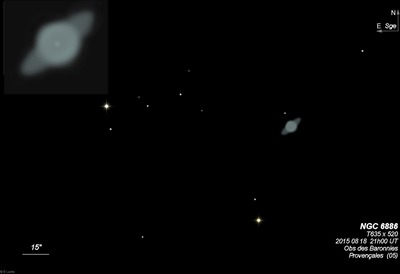
Ralph Copeland discovered NGC 6886 on 17 Sep 1884 at Dun Echt, Scotland, using a direct vision objective-prism or Secchi prism attached to a 6.1-inch refractor. He recorded "Nebula about 2 1.2" diam, equal to a 9.8 mag star." His micrometric position in Monthly Notices XLV is very accurate.
Based on Crossley photographs taken at Lick, Heber Curtis (1918) noted, "no central star can be made out. A round disk 6" in diameter, of nearly equal brightness throughout, forms the central part. Two wings (of ring structure) in p.a. 135-315° bring the total length to 9"."
300/350mm - 13.1" (9/29/84): fairly bright, very small, just non-stellar at 166x. At 415x, easily visible small disc elongated ~E-W. Forms the NW vertex of a thin isosceles triangle with a mag 10.5 star 45" SSE and a mag 10 star 1.5' E. These two brighter stars form a parallelogram with two mag 12 stars to the SE with sides of 1' and 1.5'.
400/500mm - 17.5" (11/6/99): this compact planetary was easily identified by blinking at 100x using an OIII filter as a "soft" mag 11 star. A small disc, less than 10" diameter is visible at 220x without filter. Situated at the NW vertex of a small isosceles triangle with a mag 11 star 0.8' SSE and a mag 10 star 1.6' E. The nearer star is double with a faint companion close north. NGC 6886 is clearly non-stellar at 280x-380x and slightly oval.
Notes by Steve Gottlieb